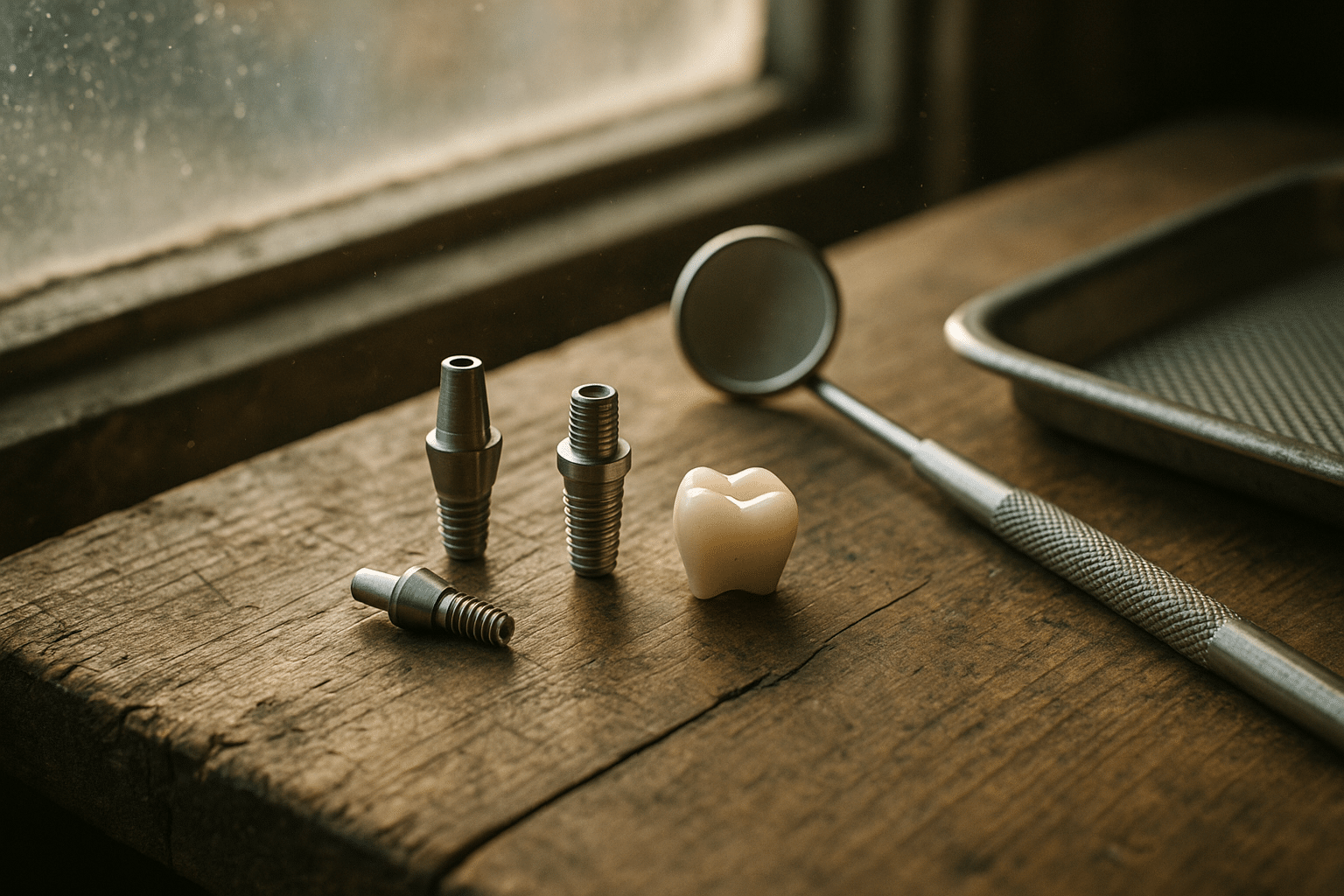
Dental Implants Explained: Benefits, Expected Longevity, and Everyday Care
This guide explains what dental implants are, how they work, and who typically benefits from them. You’ll find a balanced look at advantages compared with bridges and dentures, including a practical comparison table. We also cover expected longevity—what often lasts decades and what may need periodic replacement—and the daily care habits that support long-term success. Along the way, you’ll see expert guidance from reputable organizations and simple checklists you can use before and after treatment.
Introduction
A missing tooth can feel like a comma in a sentence—an interruption that changes the rhythm of everyday life. Dental implants offer a stable, lifelike way to fill that gap, helping many people eat comfortably, speak clearly, and smile with confidence. Because an implant integrates with the jawbone, it functions as a sturdy foundation for a crown, bridge, or even a full arch restoration. That stability is a key reason implants have become a widely used option among dentists and oral surgeons.
Still, implants are not a one-size-fits-all solution. Planning involves your medical history, bone quality, and oral hygiene habits, and success relies on thoughtful care after placement. In the sections below, you’ll learn what dental implants are, the benefits patients commonly report, realistic expectations for longevity, and everyday care tips that protect your investment. If you’re weighing options, this overview can help you ask better questions at your consultation and collaborate with your dental team.
What Exactly Are Dental Implants? Anatomy, Procedure, and Who’s a Candidate
A dental implant is a small, biocompatible post—often titanium, sometimes zirconia—that is placed in the jawbone to replace a tooth root. Over time, bone cells grow around the implant in a process called osseointegration, securing it in place. Once stable, a connector (the abutment) is attached, and a custom restoration (commonly a ceramic crown) is fitted to complete the tooth replacement. The American Dental Association’s patient resource notes that implants can be used to replace a single tooth, multiple teeth, or to help support dentures when more stability is needed (see the ADA’s overview at MouthHealthy.org: according to MouthHealthy by the ADA).
What the process involves:
- Assessment and planning: Clinical exam, X-rays, and often 3D imaging to evaluate bone volume and anatomy. Your clinician will also review medical factors like diabetes control, medications, and smoking, which can influence healing.
- Surgical placement: The implant is placed in a precisely prepared site. In some cases, a temporary tooth may be provided during healing.
- Healing and integration: Osseointegration typically takes a few months. During this phase, you’ll follow hygiene and diet instructions to protect the site.
- Restoration: Once the implant is stable, the abutment and crown are attached. Many practices color-match the crown to neighboring teeth for a natural look.
Who is a suitable candidate? The UK National Health Service (NHS) dental implant page explains that healthy gums, sufficient jawbone, and good oral hygiene are important prerequisites. People with a history of gum disease can still be candidates but may need periodontal stabilization first. Smoking has been associated with higher complication rates, and conditions that affect healing—uncontrolled diabetes, for example—need careful management. Your dentist may recommend a bone graft or sinus lift if additional bone support is needed before implant placement, particularly in the upper back jaw.
How long do implants typically last? Survival rates are frequently reported above 90% over 10 years in clinical follow-ups. The Mayo Clinic’s overview of dental implants notes that outcomes are influenced by placement technique, bone quality, and maintenance. As with any surgical procedure, risks exist—such as infection, nerve irritation, and peri-implant bone loss—so selecting an experienced clinician and following after-care instructions is essential.
A quick personal snapshot: After a bike spill, my colleague Mark opted for an implant rather than a traditional bridge to avoid altering the adjacent teeth. He appreciated the way the final crown felt “part of him,” especially when biting into crusty bread—though he admits the success had as much to do with diligent brushing and hygiene visits as it did with the hardware.
Helpful references and planning resources:
- ADA’s patient explainer: Dental implants (MouthHealthy by the ADA)
- Surgical perspective: Cleveland Clinic – Dental Implants
- Eligibility and considerations: NHS – Dental Implants
Benefits You Can Feel: Function, Confidence, and Oral Health
People choose dental implants for a mix of practical and personal reasons. Functionally, implants are designed to behave like stable roots, which can help you bite and chew more comfortably compared with removable dentures. Many patients describe a more “confident” bite—especially on foods that are harder to manage with a removable appliance. Aesthetically, custom ceramic crowns can be shaped and shaded to harmonize with your smile. From an oral health standpoint, implants don’t rely on grinding down neighboring teeth the way traditional bridges often do, and they help transmit chewing forces to the jawbone, which can support bone preservation over time. The ADA’s MouthHealthy page and the Cleveland Clinic’s guide both describe these advantages in consumer-friendly terms.
Quality-of-life measures also matter. People frequently report improvements in speaking clarity (no clicking or shifting), day-to-day comfort, and overall confidence in social situations. For those who struggle with sore spots under dentures or frequent relines, implant-supported options can reduce movement and increase stability. That said, benefits vary by individual anatomy and hygiene habits, and no single solution fits everyone’s goals or budget. A candid conversation with your dentist or oral surgeon about expectations and trade-offs is wise.
To help you compare at a glance, here’s a practical comparison “table” across common options:
Comparison: Dental Implants vs. Bridges vs. Removable Dentures
Category: Use of adjacent teeth
– Implants: Independent; doesn’t typically require altering neighboring teeth
– Fixed Bridge: Often requires shaping adjacent teeth for crowns
– Removable Denture: No tooth preparation, but may use clasps on teeth
Category: Bone preservation
– Implants: Help stimulate and preserve jawbone through load
– Fixed Bridge: Does not stimulate bone at the missing tooth site
– Removable Denture: No direct stimulation; bone resorption can continue
Category: Chewing stability
– Implants: Generally stable, anchored in bone
– Fixed Bridge: Stable when well-fitted
– Removable Denture: Can move; adhesives or implants may improve stability
Category: Longevity potential
– Implants: Many last decades with care
– Fixed Bridge: Often 7–15 years before replacement or repair
– Removable Denture: Periodic relines/adjustments; may need replacement over time
Category: Maintenance
– Implants: Brush, interdental cleaning, professional maintenance
– Fixed Bridge: Special floss threaders/brushes under pontic
– Removable Denture: Daily removal, cleaning, and overnight soaking
Category: Aesthetics
– Implants: Customized crowns; natural appearance when well-planned
– Fixed Bridge: Good aesthetics; pontic contour is key
– Removable Denture: Aesthetics vary; bulk can affect feel
Category: Surgery required
– Implants: Yes (and sometimes grafting)
– Fixed Bridge: No implant surgery
– Removable Denture: No implant surgery
Category: Treatment time
– Implants: Several months (healing/integration)
– Fixed Bridge: Often weeks
– Removable Denture: Weeks, with potential try-ins/adjustments
Category: Speech and comfort
– Implants: Feels close to natural tooth for many people
– Fixed Bridge: Generally comfortable after adaptation
– Removable Denture: Bulk and movement can affect speech for some
Category: Flexibility for future changes
– Implants: Individualized; can add implants if plan evolves
– Fixed Bridge: Changes may require remaking the bridge
– Removable Denture: Relines and adjustments possible
As you weigh these factors, browse neutral overviews like NHS guidance on implants and Mayo Clinic’s dental implant page. If you’re already comparing specific hygiene tools for cleaning around implants, you might also explore the ADA Seal of Acceptance product directory for brushes and interdental cleaners that meet certain testing standards.
Longevity and Care: How Long Implants Last and How to Look After Them
Dental implants are designed for long-term service, and many remain in place for decades. There isn’t a fixed expiration date: outcomes reflect planning, placement, your health status, and your at-home care. The visible crown attached to an implant may need replacement eventually due to normal wear, chipping, or evolving aesthetics, even when the implant itself remains stable. Organizations such as the Mayo Clinic and Cleveland Clinic note that high long-term success rates are achievable when patients maintain excellent oral hygiene and attend regular professional maintenance visits.
Key factors that support longevity:
- Daily plaque control: Meticulous brushing and interdental cleaning reduce inflammation around the implant. A low-plaque environment supports gum and bone health.
- Professional maintenance: Your hygienist and dentist will use implant-safe techniques and instruments to clean and monitor tissues and bite forces. They’ll watch for early signs of peri-implant mucositis (gum inflammation) before it progresses.
- Healthy gums matter: Gum disease bacteria can affect tissues around implants too. The CDC outlines periodontal disease risks, which also inform implant aftercare strategies.
- Systemic health and habits: Smoking, poorly controlled diabetes, and severe bruxism (clenching/grinding) can increase complication risks. Night guards and medical coordination may be recommended.
Daily care checklist for dental implants:
- Brush twice daily with a soft-bristled manual or powered brush; consider small-headed designs to reach around the implant crown.
- Clean between teeth and around the implant once daily using floss designed for implants, floss threaders, or small interdental brushes (ask your hygienist which size). Water flossers can be a helpful adjunct.
- Rinse with an alcohol-free mouthrinse if recommended by your clinician.
- Schedule routine professional cleanings and exams; your team may suggest 3–4 month intervals if you’re at higher risk.
- Wear a night guard if you clench or grind; it helps distribute forces and protect restorations.
- Avoid using teeth as tools (e.g., opening packages) and be mindful with very hard foods.
When to call your dentist:
- Persistent bleeding or puffiness around the implant
- Bad taste or odor that doesn’t resolve with cleaning
- Any mobility, clicking, or discomfort when chewing
- Chipped crown or loose screw-retained restoration
If you’re new to interdental cleaning, this quick refresher may help: see our brushing and interdental guides at brushing techniques and early signs of gum inflammation. For product selection, browse implant-friendly tools in the ADA Seal directory and consult your hygienist for sizing, especially if you have a custom contour around the implant crown.
Frequently Asked Questions
Dental Implants: FAQ
Do dental implants hurt?
Most people report manageable discomfort after surgery, often similar to an extraction. Your provider will recommend pain relief and after-care instructions to keep you comfortable during healing.
How long does the process take?
From assessment to final crown, timelines range from several weeks to a few months, depending on bone healing and whether grafting or extractions are needed.
Are implants safe for people with diabetes?
Many people with well-controlled diabetes do well with implants. Your dentist will coordinate with your physician and may suggest strategies to support healing.
Will I set off a metal detector?
Dental implants typically do not trigger metal detectors. They are small and not ferromagnetic in the way larger orthopedic implants can be.
What if I already have gum disease?
You may still be a candidate once active disease is treated and stabilized. Maintenance visits and strict home care are especially important afterward.
Do implants ever fail?
Failures can occur, often related to infection, inadequate integration, or overload. Early detection and intervention improve outcomes, so regular follow-ups matter.
Can I whiten an implant crown?
No. Whitening affects natural tooth enamel but not ceramic crowns. If you plan whitening, complete it before color-matching your implant crown.
What’s the difference between titanium and zirconia implants?
Titanium is widely used and well-studied. Zirconia is a metal-free alternative some patients prefer for specific reasons; your clinician can advise based on your case.
Conclusion
Dental implants offer a stable, natural-feeling way to replace missing teeth, with potential benefits for chewing comfort, confidence, and long-term oral health. Their longevity often stretches for decades when placement is well-planned and daily care is consistent. If you’re considering implants, start with a thorough consultation, discuss your goals and medical history, and ask about maintenance routines that fit your life. For a plain-language overview, explore resources from the ADA’s MouthHealthy, NHS, and the Cleveland Clinic, then bring your questions to a licensed dental professional who can tailor advice to your needs.


